Introduction
Probiotic foods are dietary supplements containing potentially beneficial bacteria or yeasts. Probiotics are “live microorganisms which when administered in adequate amounts confer a health benefit on the host”. Probiotics show several health benefits including decreasing the lactose intolerance symptoms, reducing plasmatic cholesterol levels, controlling intestinal infections, stimulation of the immune system and anti-carcinogenic activity.1 Yoghurt is a high popular fermented cow’s milk product which had been until now the best carriers for probiotics. However, the prevalence of milk protein allergies and lactose intolerance have led to a growing demand for non-dairy probiotic product2. Hence, yoghurt made from cereals such as corn-milk is launched to the market for substituting cow’s milk yoghurt. Corn-milk has good aroma and can give benefit to health especially flavonoids, carotenoids and vitamins3-5. Many non-dairy products have added probiotics to convince consumers who care about their health. Probiotics are referred to as living microorganisms that when taken in sufficient quantities (> 106 – 107 CFU/g or CFU/ml) can provide benefits to consumers6-8. Good quality yoghurt should be thick, smooth with low syneresis and has sufficient number of probiotics6.
Whey protein concentrate (WPC) widely used in fermented milk products, such as yoghurts, due to its functional effectiveness which support the growth of yoghurt starter culture and its gel-forming capability after denaturation9. Xanthan gum, an anionic hetero-polysaccharide, also used extensively in yoghurt products as stabilizer and thickening agent. Various properties of xanthan gum were reported, such as solubility and stability over a broad range of temperatures and pHs, high resistance to shear degradation, promoting of water binding capacity and decrease the syneresis in yogurt9-10. Therefore, WPC and xanthan gum are considered as a good stabilizer that could possibly promote the growth culture, decrease syneresis and increase total solid content without changing any sensory characteristics of yoghurt9-10.
Presently, there are non-thermal techniques, such as high pressure processing (HPP), to prolong shelf life, destroying pathogenic microorganisms and maintain freshness of foodstuffs. HPP (100–1000 MPa) is often used in biological and food systems, because it can inhibit undesirable microorganisms at low and/or moderate temperatures. The high pressure affects the morphology, cell membrane, cell wall, chemical reaction and the genetic mechanisms of bacteria leading to eventual cell death but does not break up biological compounds11-13. The use of HPP offered microbiologically safe with improved performances, such as high nutritional and sensory quality, as well as improve texture14-15.
To our knowledge, study about effect of WPC and xanthan gum supplementation to promote probiotic growth in corn-milk yoghurt treated with ultra-high pressure has not been investigated and should be found out. In addition, the appropriate fermentation time for corn-milk yoghurt also should be assessed. The goal is to create a plant-based yoghurt product that offers consumers the full benefit of corn and probiotics. The process of processing with high pressure technology has been chosen as an alternative for manufacturers to produce the functional corn-milk yoghurt. Therefore, this research aimed to study the influence of various concentrations of WPC and xanthan gum on the viability of probiotic Lactobacillus casei subsp. rhamnosus TISTR 047 and the qualities of HPP treated corn-milk yoghurt.
Materials and Methods
Materials and starter cultures
Sweet corn (Zea mays L. saccharata cv. ‘Hi-brix 33’) was harvested (June on 2020) from the Center for Agricultural Resource Research Station, Chiang Mai University, Chiang Mai, Thailand. WPC and Xanthan gum were purchased from Unity Chemical Ltd. (Nonthaburi, Thailand) and Deosen Biochemical Ltd. (New Jersey, USA) respectively.
Yoghurt starter culture (a mixture of Lactobacillus delbrueckii subsp. bulgaricus and Streptococcus thermophilus) were purchased from Chr.Hansen (Hoersholm, Denmark). L. casei subsp. rhamnosus TISTR 047 was procured from Thailand Institute of Scientific and Technological Research (TISTR), Pathum Thani, Thailand.
Preparation of stock cultures
In brief, the lyophilized yoghurt starter culture was activated separately in de Man, Rogosa and Sharpe (MRS) broth (HiMedia, Mumbai, India) and anaerobically incubated at 43 ± 2 °C for 24 h. A loop of each activated cells was then taken into MRS broth before incubation at temperature of 43 ± 2 °C for 24 h. To prepare the stock cultures, 0.5% (v/v) of both inoculums were individually inoculated into 50 mL of a sterilized distill water containing 5% (w/v) yeast extract (HiMedia) plus 10% (w/v) skim milk powder and subsequently incubated at 43±2 °C for 24 h prior to use6,16.
Using WPC to promote the growth of probiotics in pressurized samples
The corn-milk prepared based on Sangkam et al.17, was mixed well with 3 levels of WPC (3.5%, 7% and 14%, w/v) as well as the control (without WPC), then made up to 12% (w/v) of total sugar with lactose. Each 50 mL of the mixed corn-milk was packed into a laminated polyamide/polyethylene bag (Siampack Industry Co.,ltd, Pathumthani, Thailand) before pressurization with a pressure of 500 MPa at ~45 °C for 10 min using a high-pressure rig (“Food Lab” 900, Stansted Fluid Power, UK). A mixture of castor oil (Chemical and Lab Supplies, Bangkok Thailand) and 98% (v/v) ethanol (Chemical and Lab Supplies) at a ratio of 20:80 (v/v) was used as the pressure transmitting medium.
To make corn-milk yoghurt, the pressurized mixed corn-milk was inoculated with 5% (v/v) of stock yoghurt starter culture (L. bulgaricus and S. thermophiles) and 5% (v/v) of stock probiotic culture (L. casei subsp. rhamnosus TISTR 047) before incubation at 43 ± 2 °C for 48 h. During fermentation, each treatment was taken at 0, 2, 4, 6, 8, 10, 12, 24 and 48 h for quality measurement such as Lactobacillus counts, acidity, pH and viscosity. All growth rates of individual L. bulgaricus, S. thermophilus and L. casei subsp. rhamnosus TISTR 047 were assessed at the initial stage to estimate the fermentation time. From the results of sample analysis, a suitable concentration of WPCs and fermentation time for the process of corn-milk yoghurt was selected.
Textural improvement of corn-milk yoghurt by xanthan gum
Corn-milk with selected WPC (optimal level) was incorporated with 3 levels (0.05%, 0.1% and 0.2% w/v) of xanthan gum and the control (without xanthan gum), then incubated at selected fermentation time, or until reaching the stationary phase. The obtained yoghurt was analyzed for the numbers of L. bulgaricus, S. thermophilus and L. casei subsp. rhamnosus TISTR 047, total titratable acidity, pH, viscosity, syneresis and water holding capacity. The improving of syneresis and water holding capacity of corn-milk yoghurt was used for selection the best formula.
Total titratale acidity and pH value analysis
Corn-milk yoghurt samples were analyzed for total titratable acidity and pH value. Total acidity test is sodium hydroxide titration according to the AOAC method No.947.0518. In brief, 10 g of yoghurt were dissolved into 10 mL distilled water, filtered through a Whatman® filter pater No.4 and then titrated with 0.1 N sodium hydroxide. Phenolphthalein solution was used as an indicator. The titration was ended with the development of pink color in the solution that persisted for more than 15 s. Total titratable acidity was expressed as based on lactic acid (w/v). For the pH measurement, the pH value of the filtrate was determined using a pH meter (Consort C830, CE, Belgium).
Measurement of viscosity
The viscosity of tested corn-milk yoghurts was carried out using a LVDV-II Brookfield viscometer (Massachusetts, USA). Briefly, 8 mL of corn-milk yoghurt was filled into a container (20 mL). A S63 spindle and a single point measuring system were used for measurement. The optimal viscosity of samples was the speed which had the percentage torque nearby to 100%17.
Determination of syneresis and water holding capacity
In briefly, 20 g of corn-milk yoghurt were spread on the surface of a Whatman® filter paper No.1 and plated on a 17 cm diameter Buchner funnel before vacuum filtering for 10 min. The weight of the filtrate were recorded and the syneresis was calculated19.
For water holding capacity analysis, 5 g of sample were centrifuged at a rotary speed of 5,000 rpm at 4 °C for 20 min. After removing the supernatant, the pellet was weight and the water holding capacity was calculated19.
Microbiological analysis
The quantities of S. thermophilus and L. bulgaricus were determined according to a procedure of International Dairy Federation20. Acidified M17 agar (Merck, Germany) containing 1 M HCl (pH 6.8) was used as selective media for S. thermophilus. After pour plating, all plates were anaerobically incubated at 37 °C for 48 h. For enumeration the viable numbers of L. bulgaricus, acidified MRS agar containing 100% glacial acetic acid (pH 5.4) was used as selective media. All plates were anaerobically incubated at 37 °C for 72 h before colony counting.
L. casei subsp. rhamnosus TISTR 047 was enumerated using MRS-NaCl agar, which was prepared according to Tharmaraj and Shah21, 40 g of NaCl (Merck, Germany) was added into 1 L of MRS agar (4% final concentration). The media was autoclaved at 121 °C for 15 min before using. All plates were anaerobically incubated at 37 °C for 72 h before colony counting.
Statistical data analysis
All experiments were carried out in Completely Randomized Design (CRD) with 3 replications. Analysis of Variance (ANOVA) and Duncan’s New Multiple Range Test (DMRT) were conducted at a significant level of P ≤ 0.05 .
Results and Discussion
The pH values of corn-milk yoghurt rapidly decreased within 4 h of fermentation process and slowly decreased in the next 6 to 12 h (Figure 1). The pH values of the control (0% WPC), 3.5%, 7% and 14% WPC added treatments at throughout of fermentation process were in the range of 6.69-4.21, 6.65-4.19, 6.62-4.13 and 6.58-4.08, respectively. In this study, it was interesting that the pH of corn-milk yoghurts with WPC added were lower than 4.6 at the first 6 h of fermentation process, that was the time required for yoghurt to ferment corn-milk until the pH decreased to 4.4-4.6 according to index of the fermentation time in the yoghurt industry. In Figure 2, the obtained results of lactic acid content were similar to the pH values. Adding WPC caused to increase the rate of lactic acid production. Sample with 14% WPC had a maximum acid content after 48 h of fermentation, while corn-milk yoghurt without WPC added had a slowly increase of lactic acid content in 12 h of fermentation. The greater acidities and the viable number of cultures with the greater percentages of added protein would be expected because of the greater nutrients from WPC. The increase in available nutrients from whey proteins may partially influence the growth of yoghurt bacteria22.
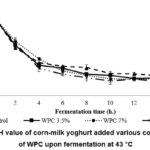 |
Figure 1: pH value of corn-milk yoghurt added various concentration of WPC upon fermentation at 43 °C |
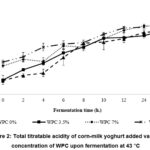 |
Figure 2: Total titratable acidity of corn-milk yoghurt added various concentration of WPC upon fermentation at 43 °C. |
In part of viscosity (cP) of corn-milk yoghurt added with various levels of WPC during fermentation (Figure 3). It was found that the viscosity of all treatments increased when incubation time increased. At the first to last hour of fermentation process, the corn-milk yoghurt with 14% WPC had the highest viscosity followed by the yoghurt with 7%, 3.5% and the control, respectively. During the first 8 h, the viscosity increased rapidly and steadily over time passed, especially, the corn-milk yoghurt containing 14% WPC. Adding WPC could increase the total solid, resulted in the viscosity of yoghurt increased.
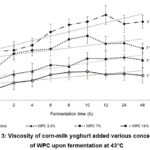 |
Figure 3: Viscosity of corn-milk yoghurt added various concentration of WPC upon fermentation at 43°C |
Figures 4 and 5 show the outgrowth of S. thermophilus and L. bulgaricus during fermentation process. In Figure 4, the maximum viable numbers of S. thermophilus in corn-milk yoghurt with 3.5% and 7% WPC as well as the control treatment were in 8 h of fermentation time, while that number in 14% WPC treatment was in 6 h which increased by 2 log CFU/mL from the initial quantity and then that declined continuously as same as the other treatments. In Figure 5, effect of WPC on the growth of L. bulgaricus was less than that of S. thermophilus. Overall, the content of L. bulgaricus found in the corn-milk yoghurt with 3.5% WPC and the control treatment increased at 4 h of fermentation, while those in the treatments with 7% and 14% WPC increased at first 6 h and then continued to decline until the end of fermentation process. In Figure 6, at 6 h of fermentation, the viable numbers of L. casei subsp. rhamnosus TISTR 047 in corn-milk yoghurt with 14% WPC (w/v) were highest, while those in the yoghurt with 7% WPC (w/v) were highest at 8 h of fermentation, those number increased rapidly and slightly changed with longer incubation period. For yoghurts with 3.5% WPC and the control treatment, the quantities of L. casei subsp. rhamnosus TISTR 047 gradually increased, that grew best at 8 h and 10 h of fermentation in corn-milk yoghurt with the control and 3.5% WPC, respectively. However, all treatments were increasing trend in the viable numbers of S. thermophilus, L. bulgaricus and L. casei subsp. rhamnosus TISTR 047 when more WPC added. Previous study reported that growth-promoting factors for probiotics and yoghurt cultures were α – lactalbumin and β-lactoglobulin which were the major proteins that found in WPC23.
In this study, although the viable numbers of L. casei subsp. rhamnosus TISTR 047 and L. bulgaricus in 7% and 14% corn-milk yoghurt (at 6 h of fermentation) had non-significant difference (P>0.05), but higher than those of the other treatments. Therefore, considering the production costs, the addition of 7% WPC and 6 h for fermentation to produced corn-milk yoghurt were selected for the next study in textural improvement of corn-milk yoghurt by xanthan gum.
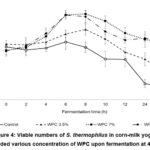 |
Figure 4: Viable numbers of S. thermophilus in corn-milk yoghurt added various concentration of WPC upon fermentation at 43 °C |
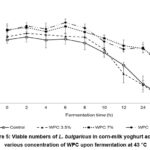 |
Figure 5: Viable numbers of L. bulgaricus in corn-milk yoghurt added various concentration of WPC upon fermentation at 43 °C |
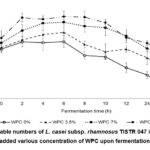 |
Figure 6: Viable numbers of L. casei subsp. rhamnosus TISTR 047 in corn-milk |
The results in Table 1 illustrated that the viable cells of yoghurt cultures and probiotics had increased trend but was non-significant difference (P>0.05) in the numbers of S. thermophilus and L. bulgaricus. Moreover, it was found that there was significant difference among the treatments in L. casei subsp. rhamnosus TISTR 047 (P£0.05). However, the treatments added xanthan gum had more viable number of L. casei subsp. rhamnosus TISTR 047 than the control. Xanthan gum is a heteropolysaccharide, and is one of the exopolysaccharides that can be used as prebiotic. Therefore, xanthan gum has prebiotic property might be supported the growth of those cultures. However, the viable numbers of those among the treatments were slightly different.
Table 1: Viability of L. bulgaricus, S. thermophilus and L. casei subsp. rhamnosus in corn-milk yoghurt incorporated with xanthan gum.
|
Xanthan (% w/v) |
L. bulgaricus (log CFU/mL)ns |
S. thermophiles (log CFU/mL)ns |
L. casei (log CFU/mL) |
|
Control |
7.95±0.28 |
9.97±0.27 |
9.97±0.07b |
|
0.05 |
7.79±0.24 |
9.42±0.29 |
10.12±0.04a |
|
0.1 |
7.83±0.27 |
10.13±0.66 |
10.00±0.10ab |
|
0.2 |
7.60±0.30 |
10.24±0.30 |
10.15±0.13ab |
a-b Means in the same column followed by the different letters are significantly different (P≤0.05). ns is non-significant difference (n=6).
Table 2 shows the pH value and total titratable acidity of corn-milk yoghurt added xanthan gum. It was found that the addition of xanthan gum resulted in corn-milk yoghurt had lower pH values and higher total titratable acidity than those in the control which the addition of 0.1% and 0.2% xanthan gum resulted in highest total titratable acidity (p£0.05) while pH values changed slightly. The results were related with the increasing of viable numbers of S. thermophilus and L. casei subsp. rhamnosus TISTR 047 in corn-milk yoghurt with xanthan gum (Table 1) and might be more produce acid value. However, the pH values of all corn-milk yoghurt samples were in range 4.40-4.45. The imperative factor in the consumer acceptance of yoghurt taste and flavor is acidity, and the pH of yoghurts is normally ranged between 4.4 – 4.524-25.
Table 2: pH and total titratable acidity of corn-milk yoghurt incorporated with xanthan gum.
|
Xanthan (%) |
pH |
Total titratable acidity (%) |
|
Control |
4.43±0.01a |
0.98±0.02b |
|
0.05 |
4.41±0.02ab |
0.97±0.01b |
|
0.1 |
4.41±0.01ab |
1.04±0.04a |
|
0.2 |
4.40±0.01b |
1.05±0.01a |
a-b Means in the same column followed by the different letters are significantly different (P≤0.05) (n=6).
From the data in Table 3, it was found that the syneresis, water holding capacity and viscosity of the corn-milk yoghurt were affected by the addition of xanthan gum. Increased levels of xanthan gum significantly reduced the extent of syneresis (P0.05) and at the same time increased water holding capacity and viscosity (P0.05). Using xanthan gum at a level of 0.2% displayed the highest viscosity value. Xanthan gum can give very high viscosity at less than 1%26. In addition, the pressure resulted in increased the viscosity also. In general, the consistency of xanthan gum at a concentration of 0.25% found to have increase by the pressure treatment26. Adding of xanthan gum at 0.1% and 0.2% could be reduced syneresis and increased water holding capacity of corn-milk yoghurt by 36.03% and 32.13% and 50.50% and 53.60%, respectively. This might be due to the effectiveness of the xanthan gum aqueous phase immobilized the protein networks in yoghurt which thus meaningfully decreased the syneresis and increased water holding capacity.
Table 3: Physical properties of corn-milk yoghurt incorporated with xanthan gum.
|
Properties |
Xanthan (%) |
|||
|
Control |
0.05 |
0.1 |
0.2 |
|
|
Syneresis (%) |
67.31±4.27a |
52.11±2.30b |
36.03±3.16c |
32.13±0.96c |
|
WHC (%) |
38.30±0.68c |
42.90±0.50b |
50.50±1.89a |
53.60±1.03a |
|
Viscosity (cP) |
2.48±0.05d |
8.67±0.10c |
15.25±0.08b |
24.74±0.17a |
a-c Means in the same row followed by the different letters are significantly different (P≤0.05) (n=6).
As expected, by increasing the level of WPC, total titrable acidity (lactic acid), viscosity and the viable numbers of S. thermophiles, L. bulgaricus and L. casei subsp. rhamnosus TISTR 047 were increased. WPC contains casein and lactose, which generally promoted lactic acid bacteria to survive better than the compositions in corn-milk. The nutrition of WPC was supported the growing of yoghurt cultures and probiotic to produce lactic acid27. The viscosity higher when increasing WPC because of total solid increased and the yoghurt cultures and probiotic had the capability to naturally secrete polysaccharides; exopolysaccharides (EPS) directly into the yoghurt matrix during fermentation. That had excellent natural stabilizing and thickeners gelling agents28-29. Therefore, the viable number of starter and probiotic cultures indicated that the addition of 7% and 14% WPC were suitable for the production of corn-milk yoghurt. At these conditions, corn-milk yoghurt had a pH lower than 4.6 at 6 h of fermentation period.
The results of the textural improvement of corn-milk yoghurt by xanthan gum indicated that the viscosity of corn-milk yoghurt with 0.2% xanthan gum was highest but the syneresis and water holding capacity of corn-milk yoghurt with 0.1% and 0.2% xanthan gum not significant difference (P>0.05). Obviously noticed that the highest amount of xanthan gum (0.2%) gave corn-milk yoghurt very high viscosity resulted led to a very elastic which could impair palatability. Thus, the optimum level of additional xanthan gum should be 0.1%. Moreover, it could also be established relationship of applying ultra-high pressure to the corn-milk with WPC and xanthan gum. The viscosity of xanthan gum solution at low concentration (0.25%) were increased by the pressure treatment26. Moreover, leads to the disruption of casein micelles and whey protein into smaller casein micelle clusters of aggregates30. The increase in viscosity of corn-milk yoghurt was partly due to the structural changes of -lactoglobulin (-LG) in WPC, when pressure was released, it unfolded and subsequently formed protein binding. This increased as the protein concentration increased31. In addition, pressure-induced protein gels differ from those induced by heat, being glossier, smoother, softer, and having greater elasticity32. In summary, a novel yoghurt produced from HPP corn-milk added with WPC (7%) and xanthan gum (0.1%) could be considered as one of the potential probiotic foods which could deliver benefits to consumers.
Conclusion
The results obtained with various levels of WPC and xanthan gum supplementation to promote probiotic growth and improve the texture characteristics of the corn-milk yoghurt treated with ultra-high pressure shown that increasing amount of WPC led to the increase in viable number of S. thermophilus, L. bulgaricus and L. casei subsp. rhamnosus TISTR 047. Addition 7% and 14% WPC to corn-milk was optimum levels to support the growth of probiotic culture for producing corn-milk yoghurt. Moreover, the results indicated that the optimum level of xanthan gum addition should be 0.1% since this level could improve syneresis and water holding capacity as well as appropriate viscosity.
Acknowledgment
The authors are grateful to Center of Agricultural Resource and Research Station, Faculty of Agriculture, Chiang Mai University, Thailand for supplying the sweet corn. Authors would like to acknowledge the Chiang Mai University and Phranakhon Si Ayutthaya Rajabhat University for supporting the facilities.
Conflict of Interest
The authors declare no conflict of interest.
References
- Chaikham P., Rattanasena, P. Combined effects of low-fat ice cream supplemented with probiotics on colon microfloral communities and their metabolites during fermentation in a human gut reactor. Food Biosci. 2017; 17: 35-41.
CrossRef - Winston J. C., Cecilia J. Brothers. Nutritional Content and Health Profile of Non-dairy Plant-Based Yogurt Alternatives. Nutr. 2021; 13: 4069.
CrossRef - Opara, C. C., Ahiazunwo, N. J., Okorie, O. Production of Soy-yoghurt by Fermentation of Soymilk with Lactobacillus Isolated from Nunu. Int J Sci Eng Investig. 2013; 2(12): 1-5.
- Sitthitrai, K., Ketthaisong, D., Lertrat, K., Tangwongchai, R. Bioactive, Antioxidant and Enzyme Activity Changes in Frozen, Cooked, Mini, Super-Sweet Corn (Zea mays L. Saccharata ‘Naulthong’). J. Food Compos. Anal. 2015; 44: 1-9.
CrossRef - Sheng, S., Li, T., Liu, R. H. Corn Phytochemicals and Their Health Benefits. Food Sci Hum Wellness. 2018; 7: 185-195.
CrossRef - Chaikham, P. Stability of Probiotics Encapsulated with Thai Herbal Extracts in Fruit Juices and Yoghurt during Refrigerated Storage. Food Biosci. 2015; 12: 61–66.
CrossRef - Kemsawasd, V., Chaikham, P. Effects of Frozen Storage on Viability of Probiotics and Antioxidant Capacities of Synbiotic Riceberry and Sesame-Riceberry Milk Icecreams. Curr Res Nutr Food Sci. 2020; 8(1): 107-121.
CrossRef - Bakr, S. A. The Potential Applications of Probiotics on Dairy and Non-dairy Foods Focusing on Viability during Storage. Biocatal Agric Biotechnol. 2015; 4: 423-431.
CrossRef - Gyawali, R., Ibrahim, S. A. Effects of Hydrocolloids and Processing Conditions on Acid Whey Production with Reference to Greek Yogurt. Trends Food Sci Technol. 2016; 56: 61-76.
CrossRef - Desplanques, S., Renou, F., Grisel, M., Malhiac, C. Impact of Chemical Composition of Xanthan and Acacia Gums on the Emulsification and Stability of Oil-in-Water Emulsions. Food Hydrocoll. 2012; 27(2): 401-410.
CrossRef - Kemsawasd, V., Chaikham, P. Alteration of Bioactive Compounds and Antioxidative Properties in Thermal, Ultra-High Pressure and Ultrasound Treated Maoberry (Antidesma bunius L.) Juice During Refrigerated Storage. Curr Res Nutr Food Sci. 2021; 9(3): 904-916.
CrossRef - Apichartsrangkoon, A., Chattong U., Chunthanom, P. Comparison of Bioactive Components in Fresh, Pressurized, Pasteurized and Sterilized Pennywort (Centella asiatica L.) Juices. High Press Res: An Int J. 2012; 32(2): 1-7.
CrossRef - Apichartsrangkoon, A., Srisajjalertwaja, S., Chaikham, P., Hirun, S. Physical and Chemical Properties of Nam Prig Noom, a Thai Green-Chili Paste, Following Ultra-High Pressure and Thermal Process. High Press Res: An Int J. 2013; 33(1): 83-95.
CrossRef - Apichartsrangkoon, A. Effects of High Pressure on Rheological Properties of Soy Protein Gels. Food Chem. 2003; 80(1): 55-60.
CrossRef - Chaikham, P., Apichartsrangkoon, A. Comparison of Dynamic Viscoelastic and Physicochemical Properties of Pressurised and Pasteurised Longan Juices with Xanthan Addition Food Chem. 2012; 134: 2194-2200.
CrossRef - Yasni, S., Maulidya, A. Development of Corn Milk Yoghurt using Mixed Culture of Lactobacillus delbruekii, Streptococcus salivarius, and Lactobacillus casei. HAYATI J Biosci. 2014; 21(1): 1-7.
CrossRef - Sangkam, J, Apichartsrangkoon, A., Baipong, S., Sriwattana, S., Tiampakdee, A., Sintuya, P. Pre-blanching Corn and Pressurization Effects on the Physicochemical and Microbiological Qualities of Corn Milk. Food Biosci. 2019; 31: 100446.
CrossRef - AOAC. Official Method of Analysis of AOAC International (17th ed.). Arlington, VA: Association of Official Analytical Chemists. 2000.
- Wu, H., Hulbert, G. J., Mount, J. R. Effects of Ultrasound on Milk Homogenization and Fermentation with Yogurt Starter. Innov Food Sci Technol. 2001; 1: 211-218.
CrossRef - International Dairy Federation. Dairy Starter Cultures of Lactic Acid Bacteria (LAB) Standard of Identity. 1997; IDF Standard 149A: 1-8.
- Tharmaraj, N., Shah, N. P. Selective Enumeration of Lactobacillus delbrueckii ssp. bulgaricus, Streptococcus thermophilus, Lactobacillus acidophilus, Bifidobacteria, Lactobacillus casei, Lactobacillus rhamnosus, and Propionibacteria. J Dairy Sci. 2003; 86: 2288-2296.
CrossRef - Amatayakul, T., Halmos, A. L., Sherkat, F., Shah, N. P. Physical Characteristics of Yoghurt Made using Exopolysaccharide-Producing Starter Cultures and Varying Casein to Whey Protein Ratios. Int Dairy J. 2006; 16: 40- 51.
CrossRef - Ibrahim, S., Bezkorovainy, A. Growth-Promoting Factors for Bifidobacterium longum. J Food Sci. 1994; 59(1): 189-191.
CrossRef - Kneifel, W. Starter Cultures for Fermented Milks. Nutr. 1992; 16: 150-156.
- Kneifel, W., Ulberth, F., Erhard, F., Jaros, D. Aroma Profiles and Sensory Properties of Yogurt and Yogurt-Related Products. I. Screening of Commercially Available Starter Cultures. Milchwissenschaft – Milk Sci Int. 1992; 47: 362-365.
- Devi, A. F., Buckow, R., Hemar, Y., Kasapis, S. Structuring Dairy Systems through High Pressure Processing. J Food Eng. 2013; 114: 106-122.
- Ibrahim, F. A. S. Studied on the Bacterial Fermentation of Soy Milk and Its Effect on the Production of Soy Milk-Based Yogurt. Egypt: Cairo University, MSc Thesis. 1997.
- Ruas-Madiedo, P., de los Reyes-Gavilan, C. G. Method for the Screening, Isolation, and Characterisation of Exopolysaccharide Produced by Lactic Acid Bacteria. Int Dairy J. 2005; 12: 163-171.
CrossRef - Hutkins, R. W. Microbiology and Technology of Fermented Foods. Hoboken, N.J: Wiley Blackwell. 2006.
CrossRef - Penna, A. L. B., Subbarao-Gurram, Barbosa-Canovas, G. V. High Hydrostatic Pressure Processing on Microstructure of Probiotic Low-Fat Yogurt. Food Res Int. 2007; 40: 510-519.
CrossRef - Ancos, B., Pilar-Cano, M., Gómez, R. Characteristics of Stirred Low-Fat Yogurt as Affected by High Pressure. Int Dairy J. 2000. 10: 105.
CrossRef - Supavititpatana, T., Apichartsrangkoon, A. Combination Effects of Ultra-High Pressure and Temperature on the Physical and Thermal Properties of Ostrich Meat Sausage. Meat Sci. 2007; 76: 555-560.
CrossRef

This work is licensed under a Creative Commons Attribution 4.0 International License.

